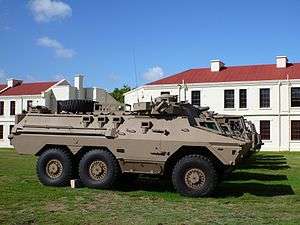Ratel IFV
| Ratel 20 | |
|---|---|
|
Ratel 20 at the Castle of Good Hope, Cape Town | |
| Type | Infantry fighting vehicle |
| Place of origin | South Africa |
| Service history | |
| In service | 1977 – present |
| Production history | |
| Designed | 1968 |
| Produced | 1974 |
| Specifications | |
| Weight | 18.5 tonnes (18,500 kg) |
| Length | 7.212 metres (23.66 ft) |
| Width | 2.516 metres (8.25 ft) |
| Height | 2.915 metres (9.56 ft) |
| Crew | 3 + 7 |
|
| |
| Armor | 20 mm (0.79 in) |
Main armament | 20 mm (0.79 in) autocannon |
Secondary armament |
|
| Engine |
D 3256 BTXF 6-cylinder in-line turbocharged diesel 282 hp (210 kW) |
| Power/weight | 15.24 hp/tonne |
| Suspension | Wheeled 6x6, 350 mm (14 in) clearance |
Operational range | 1,000 kilometres (620 miles) |
| Speed | 115 km/h (71 mph) (road); 65 km/h (40 mph) (off-road) |
| Ratel 90 | |
|---|---|
|
Ratel 90 | |
| Type | Fire Support vehicle |
| Place of origin | South Africa |
| Specifications | |
| Weight | 19 tonnes (19,000 kg) |
| Length | 7.21 m (23.65 ft) |
| Width | 2.7 m (8.86 ft) |
| Height | 2.395 m (7.86 ft) |
| Crew | 4 + 6 |
|
| |
| Armor | 20 mm (0.79 in) |
Main armament | 90 mm (3.54 in) GT-2 semi-automatic gun |
Secondary armament |
|
| Engine |
ADE 407 TI turbocharged diesel 315 hp (235 kW) |
| Power/weight | 15.24 hp/tonne |
| Suspension | Wheeled 6x6, 350 mm (14 in) clearance |
Operational range | 1,000 kilometres (620 miles) |
| Speed | 105 km/h (65 mph) (road); 30 km/h (19 mph) (off-road) |
The Ratel is the basic infantry fighting vehicle (IFV) of the South African National Defence Force's mechanized infantry battalions. Ratel is the Afrikaans name for the honey badger, which has a reputation as a ferocious fighter.
History
Circa 1970, the South African Defence Force identified the need for an infantry combat vehicle (ICV) in accordance with requirements for its relatively new doctrine of mobile warfare. The resultant product was the Ratel Infantry Combat Vehicle that, contrary to some views, was a totally new requirement and not a replacement for the Alvis Saracen. In fact, the Saracens were retained in their original roles for some years after Ratel entered service and even underwent an upgrade (Project Fellies) before they were eventually retired.
The 6x6 Ratel was engineered largely from a prototype furbished by a local subsidiary of Büssing.[1] A number of other foreign designs, including the Panhard M3, EE-11 Urutu, Berliet VXB-170, and Thyssen Henschel UR-416, were also evaluated for the programme.[2][3] Development commenced in 1971, with General Magnus Malan reporting to parliament three years later that the Ratel had been "successfully industrialised".[4] Mass production of a base Ratel-20 chassis peaked in 1976, and the vehicle entered combat deployment in 1977. Other variants, including the improved Mark II and Mark III versions of the basic Ratel, were phased in throughout the 1980s. Mark I vehicles were upgraded to Mark II and III standard during refits. Over a thousand Ratel vehicles have been manufactured.
The Ratel was the first wheeled IFV to enter military service, and is generally regarded as an influential design; a number of other countries have since produced vehicles similar to the Ratel, including the Chinese WZ-523. Büssing also sold the rights to its original prototype to Belgium, which in turn produced the SIBMAS.[1] The Ratel-20 is the primary squad IFV, with the Ratel-60, Ratel-90, and Ratel-ZT3 (the anti-tank guided missile version) used primarily in anti-armour, support, and reconnaissance elements within a battalion. The vehicle usually carries a crew of two or three men, with a seven-man infantry squad. In the Ratel-20 squad vehicle, the vehicle commander doubles as the section leader, while in the Ratel-90 fire support version, the commander doubles as the gun loader.
The vehicle will be replaced in the South African military by 264 Patria AMV vehicles in "Project Hoefyster".[5]
Land Systems OMC has developed the next generation iKlwa Multi-role Armoured Vehicle based on the Ratel's design.
Vehicle characteristics
The vehicle was designed with the South African environment and the combat experience of the South African Defence Force (SADF) foremost in mind. For example, it has considerably more firepower than most comparable infantry fighting vehicles, ranging from machine guns up to a 90-mm cannon. Modern versions can therefore be considered to have evolved into multirole armoured vehicles from their original infantry fighting vehicle design. The Ratel also has on-board potable water storage tanks, a necessity for operations in arid areas, and a very wide operational radius of 1,000 kilometres (620 miles) (compared to 450 kilometres (280 miles) for the M2/M3 Bradley).
Mobility
It is wheeled, with six run-flat tires for the long-distance speed, mobility, and ease of maintenance that tracked vehicles lack. Furthermore, unlike the United States Army's M2/M3 Bradley or Warsaw Pact's BMP designs, the Ratel does not need to be transported long distances on trains or trailer trucks; it can simply be driven to the destination. The Ratel's ground clearance and cross-country performance are very good: certainly adequate for the generally rolling and arid terrain it usually operates in, but also adequate for the densely wooded bush and loose sands of southern Angola where it saw most operational service. The vehicle has a ride comfort that crews view as comparable to civilian cars when on roads. Off-road mobility is comparable to tracked vehicles such as the Olifant tank, as demonstrated during the 1987–1988 Operation Moduler, where Ratel-equipped units made a long-distance dash from Rundu in Namibia to the Lumba River in Angola over poor or nonexistent roads. During the Angolan conflict, SADF crews also praised the visibility imparted by the vehicle's high profile; although it makes the Ratel a bigger target, it enables the crews to see the surrounding area more easily when maneuvering in very tall bush.
Landmine protection
The Ratel's design also gives far more consideration to protection against land mines than most armoured vehicles of its era, reflecting SADF experience and priorities. Like the Casspir and Buffel vehicles, the bottom of the hull is angled and reinforced so as to deflect mine blasts out to the sides. The Ratel's wheels, if damaged, are also much easier to repair or replace than tracks. The vehicle also has multiple doors and hatches; the two main doors are located in the vehicle's sides, but a small rear door and roof hatches allow the crew to exit the vehicle from many directions at once, or to more easily dismount under cover during an ambush.
Armour
The Ratel is relatively lightly armoured, in order to preserve mobility, weapons space, and range. The vehicle is well-protected against bullets and artillery shell splinters, but is vulnerable to anti-tank guns, automatic cannon such as the Warsaw Pact 23 millimetres (0.91 in) AA guns (which were often used in a ground-fire role in Angola), rocket-propelled grenades and guided missiles. The SADF's experience during the South African Border War in Angola showed that Ratels were far more likely to be faced with small-arms fire and mines in small-unit actions or ambushes than to run into main battle tanks in pitched battles.
Armament

The basic Ratel's (designated Ratel-20) primary armament consists of a Denel Land Systems GI-2 20 millimetres (0.79 in) autocannon mounted in a non-powered turret at the front of the vehicle, supplemented by a coaxial 7.62 × 51 mm NATO machine gun and a 7.62 × 51 mm calibre pintle-mounted machine gun mounted by the commander's roof hatch. The 20 mm (0.79 in) cannon is belt fed and has a high rate of fire. Ammunition is selected for specific engagements and typically consists of a combination of HE (high explosive) and APTC (armour piercing tungsten carbide) rounds in sequence. The APTC is capable of destroying a tank as evidenced during Operation Protea in Xangongo.[6] The Ratel also has four rifle ports on each side of the vehicle, allowing the infantrymen to fire from within the vehicle. An additional pintle-mounted dual machine gun (removed on later models), accessed from a roof hatch, is located at the rear of the Ratel's upper deck and provides cover for the Ratel's rear quarter. The crew consists of commander, driver, gunner as well as seven infantrymen.
The Ratel-60 and Ratel-90 variants are otherwise identical, save that the former mounts a 60 millimetres (2.4 in) breech-loading mortar in turrets modeled on the Eland-60 armoured cars, and the Ratel-90 mounts a Denel 90 millimetres (3.54 in) gun in a turret modeled on that of the Eland-90 armoured car. The Ratel 90 weighs approximately half a ton more than a Ratel-20. The 60mm mortar is most effectively used in firing smoke shells, and is generally useless against armoured vehicles or dug-in troops.
Much like the BMP-1, the Ratel-90 is an unusual vehicle in that it can carry an infantry squad while boasting relatively large armament. It was developed as an interim replacement to the Eland-90 pending the introduction of the Rooikat. Some armored car squadrons deployed to the Angolan area of operations during the South African Border War favoured Ratel-90s instead of Elands because the Ratel had a much greater radius of action.[7]
On the rare occasions during the border war when South African expeditionary forces encountered Angolan or Cuban armour, such as T-34 and T-54/55 tanks, they achieved successes through manoeuvrebility and only at very short ranges. During Operation Askari the 61 Mechanised Infantry Battalion Group found that an Angolan T-55 required multiple hits from the Eland and Ratel-mounted 90mm guns to disable it, and in later campaigns Ratels only engaged tanks in platoons and at extremely close range.
Ratel ZT3
The anti-tank guided missile variant, the Ratel ZT-3, is armed with the 127 millimetres (5.0 in) Ingwe (Leopard) anti-tank guided missile (ATGM). The Ratel ZT3 is basically a Ratel-20 with a different turret, which is fitted with a three-round missile launcher. Other missiles are carried within the hull.
The Ratel ZT-3 entered service (albeit in prototype form) with the SADF in the late 1980s, in time for Operation Moduler, and gave yeoman service against enemy armour at the Battle of Cuito Cuanavale. The SADF was previously limited to the obsolete French-designed ENTAC wire-guided ATGM, which was usually transported in Land Rovers, Unimogs or other unarmoured vehicles.
Typical deployment
A typical SANDF mechanized company consists of 16 Ratels, with three four-vehicle rifle platoons and a two-vehicle command section. A battalion's support company consists of 3 Ratel 90s, 3 MILAN teams in APCs or Ratel-ZT3s, 6 Ratel 81 mm mortar vehicles and 3 Ystervark self-propelled 20 mm AA vehicles. Since SADF units frequently operated in ad hoc task forces during the South African Border War, unit structures and equipment varied widely. At the time of Operation Moduler in 1988, for example, the 61 Mechanised Infantry Battalion Group's task force consisted of two infantry companies with Ratel 20s, an armoured car squadron with fourteen Ratel 90s, a mortar platoon with twelve 81mm Ratels, an anti-tank company with a mix of ATGW and Ratel 90 vehicles, as well as other attachments. Fire belt actions were a formidable tactic, typically with the 20 millimetres (0.79 in) cannon firing almost continuously during a specific advance onto target.[8] They were also used as command vehicles given their large storage capacity. These vehicles were kitted out with an array of radio and other equipment as needed. During the latter stages of the civil unrest in South Africa, Ratels were often used for counter insurgency purposes in townships.[6]
Variants
| Variant | Description | Comment | Image |
|---|---|---|---|
| Ratel 20 | Original version | French designed turret |  |
| Ratel 60 | crew of 3 plus 7 infantry | turret is identical to that of the Eland 60 with a 60 mm (2.4 in) breech-loading mortar |  |
| Ratel 81 | no turret | an 81 mm (3.2 in) mortar is installed in the crew compartment for use as a fire support platform |  |
| Ratel 90 | crew of 3 plus 6 infantry | turret is identical to that of the Eland 90. Primary role: fire support for the Mechanized Battalions | 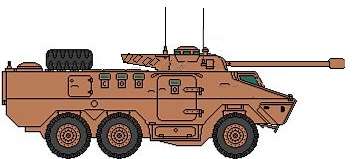 |
| Ratel 120 | 120 mm (4.7 in) mortar carrier | Prototype only | |
| Ratel Command | crew of 9 men | two-seater turret with a .50 BMG (12,7mm) machine gun | 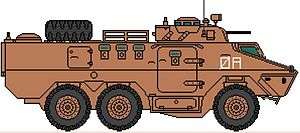 |
| Ratel EAOS | Enhanced Artillery Observation System | Artillery Support |  |
| Ratel Maintenance | setup as a mobile workshop | ||
| Ratel ZT3 | anti-tank guided missile turret | with a launcher containing three ZT3 Ingwe laser guided missiles and additional missiles stored within the hull | 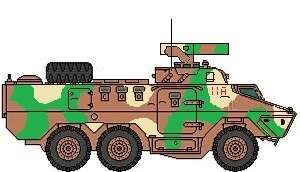 |
| Ratel Logistic | 8x8 logistic vehicle | Only 2 prototypes were built |  |
| Ratel AA | Anti-aircraft platform | Jordanian variant only, modified by KADDB before entering service with the JAF. New turret armed with a twin 23 mm cannon removed from Ukrainian supplied BTR-94 |  |
Derivatives
- Iklwa - A prototype built by BAE Systems Land Systems South Africa that is based on the Ratel but with the hull and drive train upgraded and the engine moved from the rear to the front

Operators
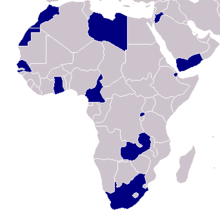
 Cameroon: 12 operated by the Rapid Intervention Battalion.[9]
Cameroon: 12 operated by the Rapid Intervention Battalion.[9] Djibouti: 9[10]
Djibouti: 9[10] Ghana: 39[11]
Ghana: 39[11] Jordan: 321[12]
Jordan: 321[12] Libya[11]
Libya[11] Morocco: 70 Ratel-20[13]
Morocco: 70 Ratel-20[13] Rwanda: 35[14]
Rwanda: 35[14]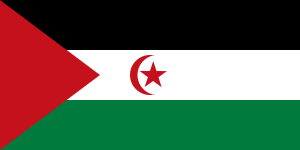 Sahrawi Arab Democratic Republic[13]
Sahrawi Arab Democratic Republic[13] Senegal: 14 Ratel-20[12]
Senegal: 14 Ratel-20[12] South Africa[15]
South Africa[15] Yemen[16]
Yemen[16] Zambia: 14[11]
Zambia: 14[11]

Combat History
- South African Border War
- Western Sahara War
- Southern African Development Community intervention in Lesotho
- Libyan Civil War
- Yemeni Revolution
- Yemeni Crisis (2011–present)
See also
References
- 1 2 Landgren, Signe. Embargo Disimplemented: South Africa's Military Industry (1989 ed.). Oxford University Press. pp. 83–85. ISBN 978-0-19-829127-5.
- ↑ Ratel
- ↑ Stefan, Marx. The VAB Family of Armoured Vehicles: NG and Improved Vehicles, Upgrades. pp. 1–40.
- ↑ Scholtz, Leopold (2013). The SADF in the Border War 1966-1989. Cape Town: Tafelberg. ISBN 978-0-624-05410-8.
- ↑ "Denel in Multi-billion Rand Deal". Fin24.co.za. May 17, 2007.
- 1 2 Turton, Anthony (2010). Shaking Hands with Billy. Durban: Just Done Productions Publishing (published 1 December 2010). ISBN 978-1-920315-58-0. OL 22656001M.
- ↑ Lessons of the Border War
- ↑ Nortje. P. 2003. 32 Battalion. Cape Town. Zebra Press.
- ↑ "Cameroon's BIR operates Ratel armoured vehicles | IHS Jane's 360". www.janes.com. Retrieved 2016-01-19.
- ↑ "Army Recognition". EquipmentInsight. 2012. Retrieved 7 March 2012.
- 1 2 3 "SA Ratels in Libya spur DA to call for investigation". Business Day Live. Retrieved 5 November 2014.
- 1 2 "Trade Registers". Armstrade.sipri.org. Retrieved 2013-06-20.
- 1 2 Cordesman, Anthony H. A Tragedy of Arms: Military and Security Developments in the Maghreb (November 30, 2001 ed.). Praeger Publishers. p. 62. ISBN 0-275-96936-3.
- ↑ "Ratel APC Rwanda". DefenceTalk.com. 2013-09-01. Retrieved 2013-09-11.
- ↑ Warwick, Rodney. Operation Savannah: A Measure of SADF Decline, Resourcefulness, and Modernisation. Scientia Militaria, 2012, Volume 40 Issue 3 p. 364-377.
- ↑ "SA Ratels turn up in Yemen conflict". Business Day Live. Retrieved 5 November 2014.
External links
- Ratel at GlobalSecurity.org.
![]() Media related to Ratel IFV at Wikimedia Commons
Media related to Ratel IFV at Wikimedia Commons
| ||||||||||||||||||||||
| ||||||||||||||
